
|
You entered: galaxies
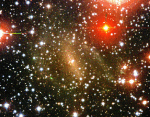 Galaxy Dwingeloo 1 Emerges
Galaxy Dwingeloo 1 Emerges
1.03.1997
Sometimes you can't see the forest for the trees. But if you look closely at the center of the above photograph, you will see a whole spiral galaxy behind the field of stars.
 Three Galaxies over New Zealand
Three Galaxies over New Zealand
11.06.2014
No, radio dishes cannot broadcast galaxies. Although they can detect them, the above image features a photogenic superposition during a dark night in New Zealand about two weeks ago. As pictured above, the central part of our Milky Way Galaxy is seen rising to the east on the image left and arching high overhead.
 Galaxy Dwingeloo 1 Emerges
Galaxy Dwingeloo 1 Emerges
2.08.1998
Sometimes you can't see the forest for the trees. But if you look closely at the center of the above photograph, you will see a whole spiral galaxy behind the field of stars.
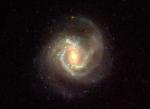 M61: Virgo Spiral Galaxy
M61: Virgo Spiral Galaxy
22.09.1998
M61 is a barred spiral galaxy located in the nearby Virgo Cluster of Galaxies. Visible in M61 are a host of features common to spiral galaxies: bright spiral arms, a central bar, dust lanes, and bright knots of stars. M61, also known as NGC 4303, in similar to our own Milky Way Galaxy.
 Galaxy Dwingeloo 1 Emerges
Galaxy Dwingeloo 1 Emerges
9.01.2000
Sometimes you can't see the forest for the trees. But if you look closely at the center of the above photograph, you will see a whole spiral galaxy behind the field of stars.
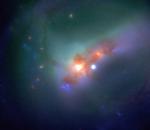 ESO202-G23: Merging Galaxies
ESO202-G23: Merging Galaxies
1.01.1999
ESO202-G
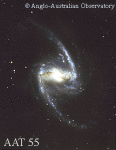 Barred Spiral Galaxy NGC 1365
Barred Spiral Galaxy NGC 1365
19.05.1997
Many spiral galaxies have bars across their centers. Even our own Milky Way Galaxy is thought to have a bar, but perhaps not so prominent as the one in NGC 1365, shown above. The persistence and motion of the bar imply relatively massive spiral arms.
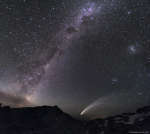 APOD: 2023 August 27 Б Three Galaxies and a Comet
APOD: 2023 August 27 Б Three Galaxies and a Comet
27.08.2023
Diffuse starlight and dark nebulae along the southern Milky Way arc over the horizon and sprawl diagonally through this gorgeous nightscape. The breath-taking mosaic spans a wide 100 degrees, with the rugged terrain of the Patagonia, Argentina region in the foreground.
 M31: The Andromeda Galaxy
M31: The Andromeda Galaxy
1.11.1997
Andromeda is the nearest major galaxy to our own Milky Way Galaxy. Our Galaxy is thought to look much like Andromeda. Together these two galaxies dominate the Local Group of galaxies. The diffuse light from Andromeda is caused by the hundreds of billions of stars that compose it.
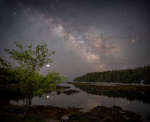 The Galaxy, the Planet, and the Apple Tree
The Galaxy, the Planet, and the Apple Tree
2.07.2020
The Old Astronomer's Milky Way arcs through this peaceful northern sky. Against faint, diffuse starlight you can follow dark rifts of interstellar dust clouds stretching from the galaxy's core. They lead toward bright star Antares at the right, almost due south above the horizon. The brightest beacon in the twilight is Jupiter, though.
|
January February March April |
|||||||||||||||||||||||||||||||||||||||||||||||||